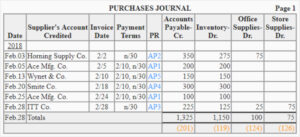Because shares held in treasury are not outstanding, each treasury stock transaction will impact the number of shares outstanding. When stock is repurchased for retirement, the stock must be removed from the accounts so that it is not reported on the balance sheet. The balance sheet will appear as if the stock was never issued in the first place. If a company chooses to repurchase some of its common stock, its assets will decrease by the amount of cash it spends even as stockholders’ equity falls by the same amount.
- Evolve Transition Infrastructure LP is focused on the acquisition, development, and ownership of infrastructure critical to the transition of energy supply to lower carbon sources.
- Retained Earnings (RE) are business’ profits that are not distributed as dividends to stockholders (shareholders) but instead are allocated for investment back into the business.
- This liability involves a written agreement whereby a property owner allows a tenant to rent for a specified period.
- The Cash Account is increased by the selling price, $28 per share times the number of shares resold, 100, for a total debit to Cash of $2,800.
In bankruptcy, the common stockholders receive nothing until the company fully pays off its creditors. The company prioritizes paying lenders, creditors, and other stakeholders when selling assets, with common stockholders receiving payment only if any funds are left after fulfilling these obligations. Common stock exemplifies the risk-return trade-off by offering potentially higher returns due to its higher risk than other securities. When stock is issued by a corporation, two accounts must be adjusted on your business’s balance sheet to record the transactions. The cash account and the stockholder’s account are both impacted by stock issues.
Common stock is the default
Preferred stock is often known as a hybrid security since it generally combines the features of both equity and debt. From stockholders point of view, the negative aspect of this class of stock is that it does not possess the voting power. It means, the preferred stockholders are not entitled to vote for the election of directors and other important matters of the corporation. Dividend payments by companies to its stockholders (shareholders) are completely discretionary. Companies have no obligation whatsoever to pay out dividends until they have been formally declared by the board. There are four key dates in terms of dividend payments, two of which require specific accounting treatments in terms of journal entries.
Below is an example screenshot of a financial model where you can see the shareholders equity line completed on the balance sheet. Retained Earnings (RE) are business’ profits that are not distributed as dividends to godaddy bookkeeping review stockholders (shareholders) but instead are allocated for investment back into the business. Retained Earnings can be used for funding working capital, fixed asset purchases, or debt servicing, among other things.

Oftentimes, people wonder what the difference between Common Stock and Equity is. Technically, they’re not something to compare and contrast as such. Thus, the Balance Sheet is the most relevant financial statement for Common Stock. It can only ever be seen as ‘Equity’, and will never form any part of the firm’s total liabilities (neither current liabilities nor non-current liabilities). From the company’s perspective, Common Stock can never be a liability.
What is a common stock, and why do people invest in it?
Typical sources of cash flow include cash raised by selling stocks and bonds or borrowing from banks. Likewise, paying back a bank loan would show up as a use of cash flow. Moving down the stairs from the net revenue line, there are several lines that represent various kinds of operating expenses. Although these lines can be reported in various orders, the next line after net revenues typically shows the costs of the sales. This number tells you the amount of money the company spent to produce the goods or services it sold during the accounting period. A company’s assets have to equal, or «balance,» the sum of its liabilities and shareholders’ equity.
What is left over is the residual amount left to the owners, known as shareholders’ equity. Common stock is the most widely available type of shares issued by a company and what you will likely encounter when trading stocks on an exchange. These shares typically come with voting rights, but are the last in line in the preference ordering of being repaid if a company goes bankrupt. Preferred shares also often lack voting rights, but do come with regular and higher dividend payments. In this respect, preferred shares are sometimes considered to be a hybrid between bonds and common stock. Treasury stock transactions have no effect on the number of shares authorized or issued.
Stockholders Equity
There is a difference between the number of shares a company is allowed to issue and the number of shares actually issued. When you provide stock to shareholders, you must adjust two accounts on your business’s balance sheet to record the transaction. Although this brochure discusses each financial statement separately, keep in mind that they are all related.
Preferred stock is listed before common stock on the balance sheet because the preferred stock is preferred in terms of dividends, assets, or both. The company provides the conversion rate in a footnote or a parenthetical note following the description of preferred stock. This acquisition of funds through the sales of common stocks will need to be recorded in a balance sheet in order to measure and keep track of the company’s finances. But before we show an example of an entry of common stock in a balance sheet which is usually done in a shareholders equity, let’s define what is shareholders equity. The $1,000,000 deducted from total stockholders’ equity represents the par value of the preferred stock as the preferred stock is not callable.
Issuing Common Stock with a Par Value in Exchange for Property or Services
Instead, Maine issues them directly in exchange for the land and records the transaction as follows. This means that if you want to directly influence decision-making within a company as a shareholder, you’ll almost certainly want to own common stock instead of preferred stock. We’ll touch on the difference between common stock vs preferred stock further down. Thus, technically, it’s possible for a company to incur 0 future economic costs to common stockholders (although this isn’t likely).
A 10% stake, for instance, can be sold for $10,000 if the value of your company is $100,000. For the investor who purchases common stock, it represents an investment in the company and is therefore an asset for the investor. The value of the common stock can fluctuate over time based on the performance of the company and market conditions. If the company does well, the value of the common stock may increase, and if the company does poorly, the value of the common stock may decrease.
Where the difference between the shares issued and the shares outstanding is equal to the number of treasury shares. Figure 5.60 shows what the equity section of the balance sheet will reflect after the preferred stock is issued. The premium on common stock is the difference between the par value of a share of stock and the price at which a business sells the share to investors. Par value is the face value printed on a stock certificate; it is usually quite small, with $0.01 per share being a common amount. For example, if ABC Company sells a share of common stock to an investor for $10, and the stock has a par value of $0.01, then the premium on common stock is $9.99.
Understanding the Financial Performance of ThredUp Inc. Class A … – Clayton County Register
Understanding the Financial Performance of ThredUp Inc. Class A ….
Posted: Tue, 01 Aug 2023 13:30:01 GMT [source]
The acknowledgment of the asset (cash or another asset) is then recognized. Finally, the number of shares outstanding refers to shares that are owned only by outside investors, while shares owned by the issuing corporation are called treasury shares. Stockholders Equity provides highly useful information when analyzing financial statements. In events of liquidation, equity holders are last in line behind debt holders to receive any payments. Shareholders’ equity is the amount owners invested in the company’s stock plus or minus the company’s earnings or losses since inception.
If you receive capital in excess of par value, create two cash account entries to allocate the money received for each category. Some of these terms have been examined previously, others have not. Gains and losses in the worth of these investments were not included within net income.
The par value collected from the issued stock must be recorded on the right side of the balance sheet. The amount of stock you issue differs from the amount of stock your company can issue. When you establish a corporation, the number of shares your business is authorized to issue is listed on the Articles of Incorporation filed with your home state. When shares are actually issued, the remaining number of shares your company is authorized to issue decreases. Cash flow statements report a company’s inflows and outflows of cash.
Information regarding the par value, authorized shares, issued shares, and outstanding shares must be disclosed for each type of stock. If a company has preferred stock, it is listed first in the stockholders’ equity section due to its preference in dividends and during liquidation. The company plans to issue most of the shares in exchange for cash, and other shares in exchange for kitchen equipment provided to the corporation by one of the new investors. Two common accounts in the equity section of the balance sheet are used when issuing stock—Common Stock and Additional Paid-in Capital from Common Stock.
This is a short-term liability usually from funding by a bank for a line of credit, for example. The next line is money the company doesn’t expect to collect on certain sales. This could be due, for example, to sales discounts or merchandise returns. Current liabilities are obligations a company expects to pay off within the year. Long-term liabilities are obligations due more than one year away.
Cash flows provide more information about cash assets listed on a balance sheet and are related, but not equivalent, to net income shown on the income statement. But combined, they provide very powerful information for investors. And information is the investor’s best tool when it comes to investing wisely. The first part of a cash flow statement analyzes a company’s cash flow from net income or losses. For most companies, this section of the cash flow statement reconciles the net income (as shown on the income statement) to the actual cash the company received from or used in its operating activities.
If this stock was not selling on a stock exchange, fair value might not be apparent. In that situation, the Maine Company should recognize the land at its own fair value of $125,000 with an accompanying $5,000 increase in the capital in excess of par value account. To illustrate, assume that a potential investor is willing to convey land with a fair value of $125,000 to the Maine Company in exchange for an ownership interest. During negotiations, officials for Maine offer to issue ten thousand shares of $1 par value common stock for this property. The shares are currently selling on a stock exchange for $12 each.
